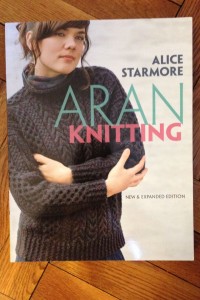Today I went through the original Aran Knitting (hardcover, 1997) and the new and expanded edition Aran Knitting (trade soft cover, 2010). Most of the original sweaters were included in “new and expanded”. Some were recolored and rephotographed. I really didn’t feel that the difference was really great in the update. I loved the red-haired model from the original book rather than the brunette used in the revised book, but that doesn’t really matter in terms of the sweaters.
The man’s sweater above is shown on the new book as the cover sweater on a woman. It was the one I’ve chosen to knit, even though I haven’t made much headway on the knitting.
The other sweaters (a few shawls and hats) are mainly classics that perfect for knitters who love cables. I was thinking that the two shawls (a bit heavy for shawl wearing) would be terrific as throws if they were made slightly wider. A few of the sweaters are a bit long with an ’80s vibe. That could be easily changed by a knitter with some skill in adaption.
My review of two sweaters in the expanded issue:
Boudicca’s Braid (Celtic Art based). I really don’t like this one. I would say “hate”, but that’s a pretty strong word. This cardigan doesn’t add much to the book that is until this sweater based on one-color beautiful designs.
Eala Bhan (Alice designed this for herself). This is modern and beautiful. I do love this cardigan. It has very long instructions, but she says it’s not difficult to knit.
The final section is based on designing your own Aran sweater. I think it would be best used to help adjust a pattern, but for someone who wants to create a unique sweater. There is two pages that discuss blocking, seaming, making tassels and fringe and the care of wool garments. There is also “a word from your sponsor” with info on buying Alice Starmore Yarns. I do think this is really good for those who want to make the sweaters as they appear in the book.
Alice gives a web site – alicestarmore.com – which didn’t seem to go anywhere when I clicked on textiles. I also looked at virtualyarns.com where yarn, books and patterns by Alice can be obtained. This site seems good and up-to-date.
I give this book a thumbs up.
Worth keeping and having in my library. At this point I might keep both copies as I like the man’s version in the early book and the woman’s in the later version. One day I might have to choose and give up one or the other…..






